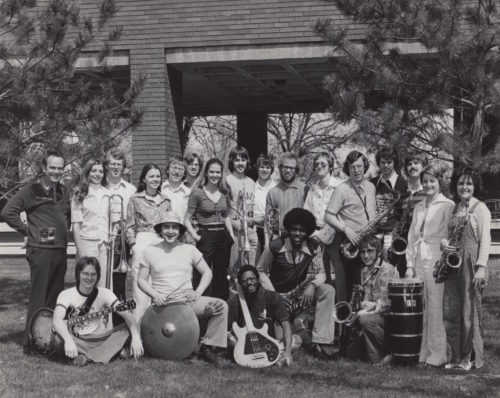
Robert Weast founded the Drake Jazz Band in 1969. He is pictured, far left, with the Drake Jazz Band outside of Harmon Fine Arts Center in 1974. Photo courtesy of Robert Weast
How Drake University got into the jazz groove
By Robert Weast
To quote the title of a song by jazz icon John Coltrane, “Things ain’t what they used to be.”
These days, students who aspire to be professional jazz and studio musicians can enroll in Drake University’s Jazz Studies program to learn jazz styles, history, improvisational techniques, arranging and composition, and gain valuable experience in live performance and studio recording settings. By the time they graduate with a degree in music with a Jazz Studies concentration, they will have gained experience as a soloist and member of a big band or orchestra, and have played with large and small ensembles to prepare them for a career in jazz.
But the path to becoming a trained jazz musician at a college or university, including Drake University in Des Moines, wasn’t always that easy because of stereotypes about the music and the people who played it.
The early reluctance at Drake University to include jazz in its curriculum in 1969 can be explained by the gulf between jazz and classical music and musicians. The 1931 Duke Ellington song, “If it ain’t got that swing it don’t mean a thing” typified the attitude of jazz musicians. In years past, jazz players called classical musicians “long hairs” and “square.” And classical musicians looked down upon jazz as inferior, thinking it should stay in dance halls, drinking joints, speakeasies and nightclubs. Music departments of college and universities, as well as high schools, frowned upon jazz being considered in their curriculum, and were, for many years, hostile against it. But as history has shown us, time has rectified this prejudice.
Jazz players of the 1920s, 30s and 40s didn’t have the modern advantage of playing in school jazz band programs, or taking jazz lessons and courses. Early players developed their skill, either by just playing in various ensembles, or by taking private non-jazz oriented lessons.
Jazz eventually worked its way into the school curriculum, including at Drake University, because of an organic groundswell of amateur groups playing on their own, outside of the school.
TO READ MORE FASCINATING STORIES ABOUT IOWA HISTORY, subscribe to Iowa History Journal. You can also purchase back issues at the store.
